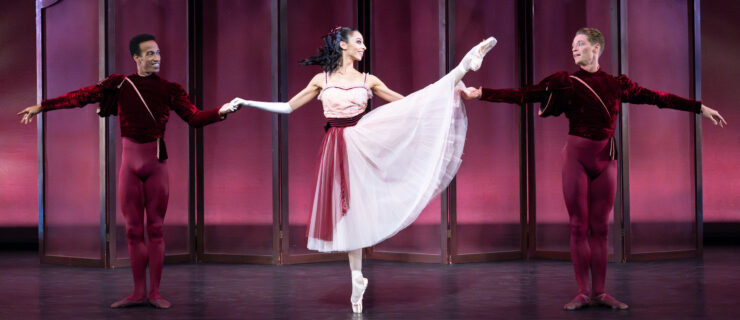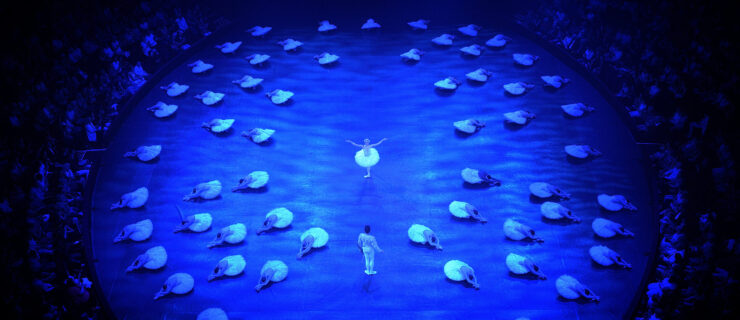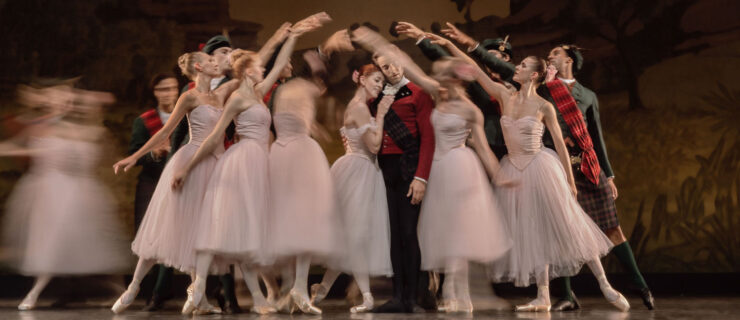Inside a Great Partnership
In the ballet world, great partnerships are rare. The unique chemistry of a splendid ballerina and her attentive partner can hold audiences spellbound. Witnessing a pas de deux by extraordinarily simpatico dancers can fundamentally change the way one perceives ballet.
At American Ballet Theatre, Paloma Herrera and Marcelo Gomes deliver that special combination of ballet and theater. In their interpretation of Swan Lake, for example, their legato lines in the “white” acts contrast with the bravura of the climax of the Black Swan pas de deux. They constantly feed off of each other, not in a competitive way, but by building on the drama of the moment. In a contemporary ballet like William Forsythe’s workwithinwork, Herrera and Gomes mutually push each other’s physicality to the ultimate limits.
Truly magnificent partnerships are legendary. Think of Margot Fonteyn’s elegance paired with Rudolph Nureyev’s prowess, or the unabashed passion of Alessandra Ferri and Julio Bocca. Chemistry in partnerships like these is a mysterious element—some dancers just seem to click from the start. But compatibility alone doesn’t guarantee a fascinating pas de deux. Years of working together in the studio to perfect musicality, transitions, lifts and character development are required.
When dancing solo, Herrera and Gomes are wonderful. But when they step onto the stage together, they ignite their own unique brand of technical and artistic fire. The first ballet they danced together, Kenneth MacMillan’s Romeo and Juliet, proved that there was a singular quality to their combined talents—almost like blending two rich forms of coffee to make a better brew. Gomes was still in the corps, while Herrera was a principal dancer, but they hit it off instantly. “From the very beginning, Marcelo was so incredible and professional,” says Herrera. “He is a very natural partner. He was so mature, and I don’t mean just technically.”
Gomes says he was initially intimidated when he was cast opposite Herrera, but he got over it quickly. “As a young dancer, you want to please your ballerina, and it’s no different now. We felt comfortable from the beginning.” He cites a rehearsal of one passage in the balcony pas de deux of Romeo and Juliet when he knew they were in synch. “I remember a particular moment where she does a flip and she has to totally trust you,” he says. “You have to catch her in the air and spin her around. Paloma was totally open to trying it over and over again. I could feel that she was comfortable, and I felt the same way.”
One of the keys to their success has been an ability to communicate freely during rehearsals and performances. “We have the same work ethic and the same point of view about what we want,” says Herrera. “There is never tension between us. Even if there is someone at the front of the room who is very tense, we can just look at each other and get through it.”
Gomes says she routinely asks him, “Do you have any requests for me?” Leaving nothing hanging in the air adds to the security of the partnership. Gomes says, “It’s all about creating an environment where you can advance forward together.”
Not all great partnerships flow so easily. What appears to be the equivalent of a wonderful bouquet of roses onstage can be much thornier behind the scenes. Gelsey Kirkland’s analytical process in rehearsals often clashed with Mikhail Baryshnikov’s desire to get the job done. Nureyev was often downright mean to his ballerinas, even Dame Margot.
In any case, dancing together requires kinetic synchronicity, another vital component in the Gomes/Herrera partnership. “Partnering is dancing,” says Gomes. “I sometimes see people partnering and it looks like, ‘Now I am going to partner,’ and ‘Now I am doing my solo.’ It is one thing—dancing with your partner, not just trying to create the line. You are creating phrases and movement. It can take a long time, or it can be like adding water. Paloma and I have been able to find that place that is just like dancing.”
In a company like ABT with a policy of rotating partners, dancing with different artists produces varying results. “Each ballerina gives you a distinct energy, artistry and technique, so you have to adjust,” says Gomes. “For me, it’s both challenging and exciting.”
Dancers naturally have individual ways of approaching their work. Some like to feel their way into the choreography, while others prefer to break it down phrase by phrase. Matching up with a partner who shares similar viewpoints and physicality can make life easier. But in the real world of ballet companies, dancers need to be prepared to work with a number of partners. That translates to a set of challenges that, if looked at positively, can make a dancer a better, more experienced partner.
Herrera and Gomes have an exceptional rapport, and their work has evolved over time. Gomes danced his first Giselle with Herrera and they have honed their performances as they have matured. “It’s the sort of ballet that gets better with age,” says Gomes. “There is always somewhere to go.” From the beginning, they have worked on the ballet from the premise of simplicity rather than operatic grandeur. But subtle details, like the illusion of Herrera’s ethereal weightlessness in the partnered pas de poissons in the second act, have come to make the all-too-familiar choreography particularly heart stirring.
Gomes adheres to a straightforward principle in partnering: “If you just dance with the ballerina and put your back where her back is and see where she is focusing, she ends up where she needs to be,” he says. “Everything falls into place.” Gomes says he learned from and greatly admired the Ferri/Bocca partnership and the unalloyed trust they cultivated onstage, especially in the risks they were willing to take together.
Ultimately, forming a relationship that makes the audience seek out your names on the casting sheet requires a chemistry that is part sweat, part magic. “It goes beyond being a good partner,” says Herrera. “It means being there for your partner—with your eyes, with your emotions, with everything.”
Joseph Carman is a former ABT dancer and the author of Round About the Ballet..What’s true in life is true in art: A sense of cooperation can lead to
better creative energy. Four dancers with ample partnering experience weigh in on what they think can help partners partner.
What Women Want Men To Know
Communicate
In many companies, dancers are trained in various styles. Plus every dancer has a different temperament. “Be open and listen to discussion,” says Romi Beppu, a principal dancer with Ballet West. “When a partnership is a fight or a struggle, it’s no fun. You’re pulling and pushing. You need to be able to talk through problem areas. Then it becomes a two-way street as opposed to one person barking orders.”
Listen To The Music
“The music is all that you and your partner have to link you together,” says Patricia Delgado, a principal dancer with Miami City Ballet. “Just sitting down and listening to the music with your partner is one of the most beneficial things in rehearsal. Get together and figure out what you are going to do on that note or this breath. It really translates to the audience.”
Feel The Balance
Every ballerina’s axis is different. “I’m hyperextended, so I need to be more over my front leg than most women, like in a penché arabesque,” says Delgado. “Often the guy is behind you and you can’t see him. I like to feel his hands on me.”
Remember
“The biggest thing that bothers me is when we talk through and agree on things in rehearsal, then the next week we’re back at square one,” says Beppu. “Remember what we’ve discussed and remember the corrections. ”
Get Strong
When men join the corps de ballet, they often lack strength and partnering experience. Push-ups and weight training should be coordinated with technique training. “By the time you’ve been given a role, it’s too late for strength training,” says Delgado. “With a lot of the contemporary pieces—Balanchine, Tharp, Robbins—you just need sheer strength. I like to dance big and feel the man partnering me has strength and muscles.”
Concentrate
Make a smooth transition from rehearsal to performance. “You can rehearse perfectly in the studio and then onstage there is some sort of disconnection,” says Delgado. “If I don’t feel like my partner is 100 percent there for me, it’s a little shaky. I want them to be in the moment and pay attention to me.”
What men Want Women To Know
Trust
“Trust is number one,” says Joan Boada, a principal with San Francisco Ballet. “If you don’t get along, and the other person doesn’t trust you, it makes it really difficult.” And principal dancer Jonathan Porretta of Pacific Northwest Ballet says, “Trust makes everything much more cohesive and allows things to flow better. When the girls are comfortable enough to completely let go, the partnering becomes more than just partnering.”
Lighten Up
Don’t take things so seriously that the working process breaks down. “Tell me what you want. The more things my girls can tell me to make them more comfortable, the happier I am,” says Porretta. Example: Some dancers like more force than others in a pirouette. Give cheerful advice and avoid Chekhovian drama.
Take A Helping Hand
“Let the guys do their job,” says Boada. “That’s why we are there. If you don’t need a guy, it’s not a pas de deux. If something goes wrong, talk about it and fix it. Don’t bitch. Talking behind the partner’s back makes everyone insecure.”
Wear Sensible Clothing
“Sometimes in rehearsal, the women wear layered leotards that are slippery to our hands,” says Boada. Stay warm, but be smart. Make sure your clothing won’t hinder his grip or get caught in his fingers.
Take A Chance On Me
“At 5’9″, I’m short. I’m not the biggest guy, but I love to partner,” says Porretta. “I love for girls to be happy with my partnering, and I try really hard. I don’t want girls to give up on me because of my size.”
A well-cultivated partnership is priceless. But perfecting that relationship is a step-by-step process. As they say on Project Runway, “Make it work.”—JC





